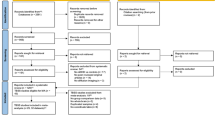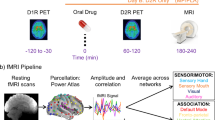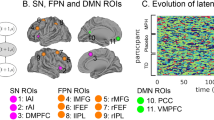Abstract
Methylphenidate is a widely prescribed psychostimulant for treatment of attention deficit hyperactivity disorder (ADHD) in children and adolescents, which raises questions regarding its potential interference with the developing brain. In the present study, we investigated effects of 3 weeks oral methylphenidate (5 mg/kg) vs vehicle treatment on brain structure and function in adolescent (post-natal day [P]25) and adult (P65) rats. Following a 1-week washout period, we used multimodal magnetic resonance imaging (MRI) to assess effects of age and treatment on independent component analysis-based functional connectivity (resting-state functional MRI), D-amphetamine-induced neural activation responses (pharmacological MRI), gray and white matter tissue volumes and cortical thickness (postmortem structural MRI), and white matter structural integrity (postmortem diffusion tensor imaging (DTI)). Many age-related differences were found, including cortical thinning, white matter development, larger dopamine-mediated activation responses and increased striatal functional connectivity. Methylphenidate reduced anterior cingulate cortical network strength in both adolescents and adults. In contrast to clinical observations from ADHD patient studies, methylphenidate did not increase white matter tissue volume or cortical thickness in rat. Nevertheless, DTI-based fractional anisotropy was higher in the anterior part of the corpus callosum following adolescent treatment. Furthermore, methylphenidate differentially affected adolescents and adults as evidenced by reduced striatal volume and myelination upon adolescent treatment, although we did not observe adverse treatment effects on striatal functional activity. Our findings of small but significant age-dependent effects of psychostimulant treatment in the striatum of healthy rats highlights the importance of further research in children and adolescents that are exposed to methylphenidate.
Similar content being viewed by others
Log in or create a free account to read this content
Gain free access to this article, as well as selected content from this journal and more on nature.com
or
References
Andersen SL, Arvanitogiannis A, Pliakas AM, LeBlanc C, Carlezon WA (2002). Altered responsiveness to cocaine in rats exposed to methylphenidate during development. Nat Neurosci 5: 13–14.
Andersen SL, Navalta CP (2004). Altering the course of neurodevelopment: a framework for understanding the enduring effects of psychotropic drugs. Int J Dev Neurosci 22: 423–440.
Ashburner J, Friston KJ (2000). Voxel-based morphometry. The methods. NeuroImage 11: 805–821.
Ashtari M, Kumra S, Bhaskar SL, Clarke T, Thaden E, Cervellione KL et al (2005). Attention-deficit/hyperactivity disorder: a preliminary diffusion tensor imaging study. Biol Psychiatr 57: 448–455.
Avants BB, Tustison NJ, Song G, Cook PA, Klein A, Gee JC (2011). A reproducible evaluation of ANTs similarity metric performance in brain image registration. NeuroImage 54: 2033–2044.
Beckmann CF, Smith SM (2005). Tensorial extensions of independent component analysis for multisubject FMRI analysis. NeuroImage 25: 294–311.
Brandon CL, Marinelli M, White FJ (2003). Adolescent exposure to methylphenidate alters the activity of rat midbrain dopamine neurons. Biol Psychiatr 54: 1338–1344.
Brenhouse HC, Andersen SL (2011). Developmental trajectories during adolescence in males and females: a cross-species understanding of underlying brain changes. Neurosci Biobehav Rev 35: 1687–1703.
Britton GB, Bethancourt JA (2009). Characterization of anxiety-related responses in male rats following prolonged exposure to therapeutic doses of oral methylphenidate. Pharmacol Biochem Behav 93: 451–459.
Carmona S, Vilarroya O, Bielsa A, Trèmols V, Soliva JC, Rovira M et al (2005). Global and regional gray matter reductions in ADHD: a voxel-based morphometric study. Neurosci Lett 389: 88–93.
Castellanos FX, Lee PP, Sharp W, Jeffries NO, Greenstein DK, Clasen LS et al (2002). Developmental trajectories of brain volume abnormalities in children and adolescents with attention-deficit/hyperactivity disorder. JAMA 288: 1740–1748.
Chen YI, Choi J-K, Xu H, Ren J, Andersen SL, Jenkins BG (2010). Pharmacologic neuroimaging of the ontogeny of dopamine receptor function. Dev Neurosci 32: 125–138.
Cox RW (1996). AFNI: software for analysis and visualization of functional magnetic resonance neuroimages. Comput Biomed Res 29: 162–173.
Elder TE (2010). The importance of relative standards in ADHD diagnoses: evidence based on exact birth dates. J Health Econ 29: 641–656.
Faraone SV, Biederman J, Morley CP, Spencer TJ (2008). Effect of stimulants on height and weight: a review of the literature. J Am Acad Child Adolesc Psychiatr 47: 994–1009.
Fearnley JM, Lees AJ (1991). Ageing and Parkinson’s disease: substantia nigra regional selectivity. Brain 114 (Pt 5): 2283–2301.
Filippini N, MacIntosh BJ, Hough MG, Goodwin GM, Frisoni GB, Smith SM et al (2009). Distinct patterns of brain activity in young carriers of the APOE-epsilon4 allele. Proc Natl Acad Sci USA 106: 7209–7214.
Fleckenstein AE, Volz TJ, Riddle EL, Gibb JW, Hanson GR (2007). New insights into the mechanism of action of amphetamines. Annu Rev Pharmacol Toxicol 47: 681–698.
Gerasimov MR, Franceschi M, Volkow ND, Gifford A, Gatley SJ, Marsteller D et al (2000). Comparison between intraperitoneal and oral methylphenidate administration: a microdialysis and locomotor activity study. J Pharmacol Exp Ther 295: 51–57.
Gerfen CR (2004). Basal Ganglia. In: Paxinos G (ed) The Rat Nervous System 3rd edn. Elsevier Academic Press: San Diego, CA. pp 455–508.
Giedd JN, Castellanos FX, Casey BJ, Kozuch P, King AC, Hamburger SD et al (1994). Quantitative morphology of the corpus callosum in attention deficit hyperactivity disorder. Am J Psychiatr 151: 665–669.
Gill KE, Pierre PJ, Daunais J, Bennett AJ, Martelle S, Gage HD et al (2012). Chronic treatment with extended release methylphenidate does not alter dopamine systems or increase vulnerability for cocaine self-administration: a study in nonhuman primates. Neuropsychopharmacology 37: 2555–2565.
Gray JD, Punsoni M, Tabori NE, Melton JT, Fanslow V, Ward MJ et al (2007). Methylphenidate administration to juvenile rats alters brain areas involved in cognition, motivated behaviors, appetite, and stress. J Neurosci 27: 7196–7207.
Grund T, Teuchert-Noodt G, Busche A, Neddens J, Brummelte S, Moll GH et al (2007). Administration of oral methylphenidate during adolescence prevents suppressive development of dopamine projections into prefrontal cortex and amygdala after an early pharmacological challenge in gerbils. Brain Res 1176: 124–132.
Jenkinson M, Bannister P, Brady M, Smith S (2002). Improved optimization for the robust and accurate linear registration and motion correction of brain images. NeuroImage 17: 825–841.
Jenkinson M, Beckmann CF, Behrens TEJ, Woolrich MW, Smith SM (2012). FSL. NeuroImage 62: 782–790.
Jensen PS, Arnold LE, Swanson JM, Vitiello B, Abikoff HB, Greenhill LL et al (2007). 3-Year follow-up of the NIMH MTA study. J Am Acad Child Adolesc Psychiatr 46: 989–1002.
Jones SR, Gainetdinov RR, Wightman RM, Caron MG (1998). Mechanisms of amphetamine action revealed in mice lacking the dopamine transporter. J Neurosci 18: 1979–1986.
Klein S, Staring M, Murphy K, Viergever MA, Pluim JPW (2010). Elastix: a toolbox for intensity-based medical image registration. IEEE Trans Med Imag 29: 196–205.
Lakhan SE, Kirchgessner A (2012). Prescription stimulants in individuals with and without attention deficit hyperactivity disorder: misuse, cognitive impact, and adverse effects. Brain Behav 2: 661–677.
Le Bihan D (2003). Looking into the functional architecture of the brain with diffusion MRI. Nat Rev Neurosci 4: 469–480.
Lerch JP, Carroll JB, Dorr A, Spring S, Evans AC, Hayden MR et al (2008). Cortical thickness measured from MRI in the YAC128 mouse model of Huntington’s disease. NeuroImage 41: 243–251.
McCutcheon JE, Marinelli M (2009). Age matters. Eur J Neurosci 29: 997–1014.
Moll GH, Hause S, Rüther E, Rothenberger A, Huether G (2001). Early methylphenidate administration to young rats causes a persistent reduction in the density of striatal dopamine transporters. J Child Adolesc Psychopharmacol 11: 15–24.
Nakao T, Radua J, Rubia K, Mataix-Cols D (2011). Gray matter volume abnormalities in ADHD: voxel-based meta-analysis exploring the effects of age and stimulant medication. Am J Psychiatry 168: 1154–1163.
Papadopulos F, Spinelli M, Valente S, Foroni L, Orrico C, Alviano F et al (2007). Common tasks in microscopic and ultrastructural image analysis using ImageJ. Ultrastruct Pathol 31: 401–407.
Pastor PN, Reuben CA (2008). Diagnosed attention deficit hyperactivity disorder and learning disability: United States, 2004-2006. Vital Health Stat 10: 1–14.
Ren J, Xu H, Choi J-K, Jenkins BG, Chen YI (2009). Dopaminergic response to graded dopamine concentration elicited by four amphetamine doses. Synapse 63: 764–772.
Schwarz A, Gozzi A, Reese T, Bertani S, Crestan V, Hagan J et al (2004). Selective dopamine D(3) receptor antagonist SB-277011-A potentiates phMRI response to acute amphetamine challenge in the rat brain. Synapse 54: 1–10.
Semrud-Clikeman M, Pliśzka SR, Lancaster J, Liotti M (2006). Volumetric MRI differences in treatment-naïve vs chronically treated children with ADHD. Neurology 67: 1023–1027.
Shaw P, Eckstrand K, Sharp W, Blumenthal J, Lerch JP, Greenstein D et al (2007). Attention-deficit/hyperactivity disorder is characterized by a delay in cortical maturation. Proc Natl Acad Sci USA 104: 19649–19654.
Shaw P, Kabani NJ, Lerch JP, Eckstrand K, Lenroot R, Gogtay N et al (2008). Neurodevelopmental trajectories of the human cerebral cortex. J Neurosci 28: 3586–3594.
Shaw P, Sharp WS, Morrison M, Eckstrand K, Greenstein DK, Clasen LS et al (2009). Psychostimulant treatment and the developing cortex in attention deficit hyperactivity disorder. Am J Psychiatr 166: 58–63.
Silk TJ, Vance A, Rinehart N, Bradshaw JL, Cunnington R (2009). White-matter abnormalities in attention deficit hyperactivity disorder: a diffusion tensor imaging study. Hum Brain Mapp 30: 2757–2765.
Sled JG, Zijdenbos P, Evans AC (1998). A nonparametric method for automatic correction of intensity nonuniformity in MRI data. IEEE Trans Med Imag 17: 87–97.
Smith SM, Jenkinson M, Johansen-Berg H, Rueckert D, Nichols TE, Mackay CE et al (2006). Tract-based spatial statistics: voxelwise analysis of multi-subject diffusion data. NeuroImage 31: 1487–1505.
Sobel LJ, Bansal R, Maia TV, Sanchez J, Mazzone L, Durkin K et al (2010). Basal ganglia surface morphology and the effects of stimulant medications in youth with attention deficit hyperactivity disorder. Am J Psychiatr 167: 977–986.
Soto PL, Wilcox KM, Zhou Y, Ator NA, Riddle MA, Wong DF et al (2012). Long-term exposure to oral methylphenidate or dl-amphetamine mixture in peri-adolescent rhesus monkeys: effects on physiology, behavior, and dopamine system development. Neuropsychopharmacology 37: 2566–2579.
Spear LP (2000). The adolescent brain and age-related behavioral manifestations. Neurosci Biobehav Rev 24: 417–463.
Teicher MH, Andersen SL, Hostetter JC (1995). Evidence for dopamine receptor pruning between adolescence and adulthood in striatum but not nucleus accumbens. Brain Res Dev Brain Res 89: 167–172.
van Meer MPA, Otte WM, van der Marel K, Nijboer CH, Kavelaars A, Berkelbach van der Sprenkel JW et al (2012). Extent of bilateral neuronal network reorganization and functional recovery in relation to stroke severity. J Neurosci 32: 4495–4507.
Volkow ND, Wang GJ, Fowler JS, Gatley SJ, Logan J, Ding YS et al (1998). Dopamine transporter occupancies in the human brain induced by therapeutic doses of oral methylphenidate. Am J Psychiatr 155: 1325–1331.
Wang R, Benner T, Sorensen AG, Wedeen VJ (2007). Diffusion toolkit: a software package for diffusion imaging data processing and tractography. Proc Intl Soc Mag Reson Med 15: 3720.
Ward BD (2000). Simultaneous inference for fMRI datahttp://afni.nimh.nih.gov/afni/doc/manual/AlphaSim.
Woods RP (2003). Characterizing volume and surface deformations in an atlas framework. Theory, applications and implementation. NeuroImage 18: 769–788.
Acknowledgements
We thank Annette van der Toorn, Gerard van Vliet, and Wouter Mol for their technical assistance. This work has been financially supported by grants of the Academic Medical Center (Fellowship; LR) and Utrecht University (High Potential program; RMD). LR, PJL and GM were supported by Priomed. PJL is supported by the Hersenstichting Nederland.
Author information
Authors and Affiliations
Corresponding author
Additional information
Supplementary Information accompanies the paper on the Neuropsychopharmacology website
Rights and permissions
About this article
Cite this article
van der Marel, K., Klomp, A., Meerhoff, G. et al. Long-Term Oral Methylphenidate Treatment in Adolescent and Adult Rats: Differential Effects on Brain Morphology and Function. Neuropsychopharmacol 39, 263–273 (2014). https://doi.org/10.1038/npp.2013.169
Received:
Revised:
Accepted:
Published:
Issue date:
DOI: https://doi.org/10.1038/npp.2013.169
Keywords
This article is cited by
-
Detecting microstructural white matter abnormalities of frontal pathways in children with ADHD using advanced diffusion models
Brain Imaging and Behavior (2020)
-
Longitudinal magnetic resonance imaging reveals striatal hypertrophy in a rat model of long-term stimulant treatment
Translational Psychiatry (2016)
-
Dopaminergic System Dysfunction in Recreational Dexamphetamine Users
Neuropsychopharmacology (2015)
-
Effect of preexposure on methylphenidate-induced taste avoidance and related BDNF/TrkB activity in the insular cortex of the rat
Psychopharmacology (2015)
-
The effects of Psychotropic drugs On Developing brain (ePOD) study: methods and design
BMC Psychiatry (2014)



